#kofun period
Text
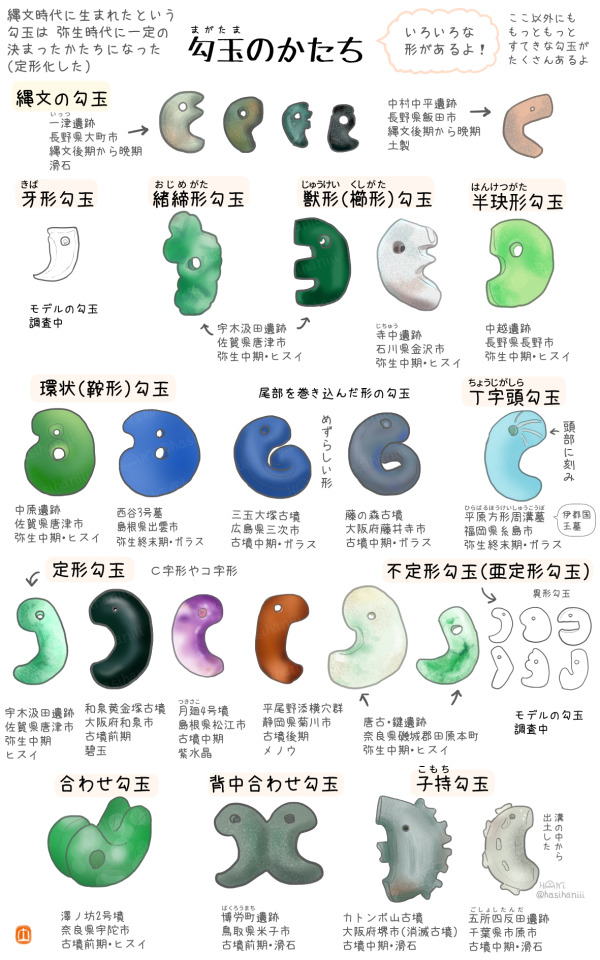

Magatama beads collection, great chart put together by author Hasihaniii. Those beads are probably familiar to all Tears of the Kindom players or Inuyasha fans ;)
Those comma shaped beads where used in prehistoric Japan, from Jômon to Yayoi and Kofun periods.
Nobody knows exactly what they were supposed to represent (a fang? a fetus? the moon? something else entirely?). We're simply certain that overtime, they became ritual objects - important enough that one is part of the 3 sacred treasures of Imperial Japan.
I wont translate the chart as it mainly details the shapes, periods, and locations where those artefacts where found :) It's great to see all the different shapes different places/eras came up with. I am especially partial to the weirdly-adorable-animal-looking Komochimagatama 子持勾玉!
#japan#history#magatama#comma shaped beads#prehistoric#jomon period#yayoi period#kofun period#zelda totk#tears of the kingdom#inuyasha
709 notes
·
View notes
Text

Head of a Warrior
Japan, 6th century, Kofun period (mid 3rd–6th century A.D.)
16 notes
·
View notes
Photo

Haniwa (Hollow Clay Sculpture) of a Warrior
“Haniwa were placed at the top of the burial mound, in the center, along the edges, and at the entrance of the burial chamber of enormous tombs constructed for the ruling elite during the Tumulus, or Kofun (ca. 200–600), period... Their diffusion is often understood to reflect a parallel spread of political power as Japan, which had been divided into a series of loosely related domains, was gradually organized into a unified state with a central government.” - MET
15 notes
·
View notes
Photo

Excavated Artifacts Curved Beads(komotimagatama and usutama)(Kofun Period)
8 notes
·
View notes
Text
Japan
Japan is a fascinating country that has a rich history, culture, and society. It is an archipelago located in the Pacific Ocean, comprising of four main islands and several smaller ones. Japan has a population of over 126 million people, making it the world’s 11th most populous country. The country has a unique identity that has been shaped by its geography, history, culture, and economy. This…

View On WordPress
#Azuchi-Momyama Period#Edo Period#Heian Period#Heisei Period#Jomon Period#Kamakura Period#Kofun Period#Meiji Period#Muromachi Period#Nara Period#Showa Period#Taisho Period#Yayoi Period
0 notes
Text
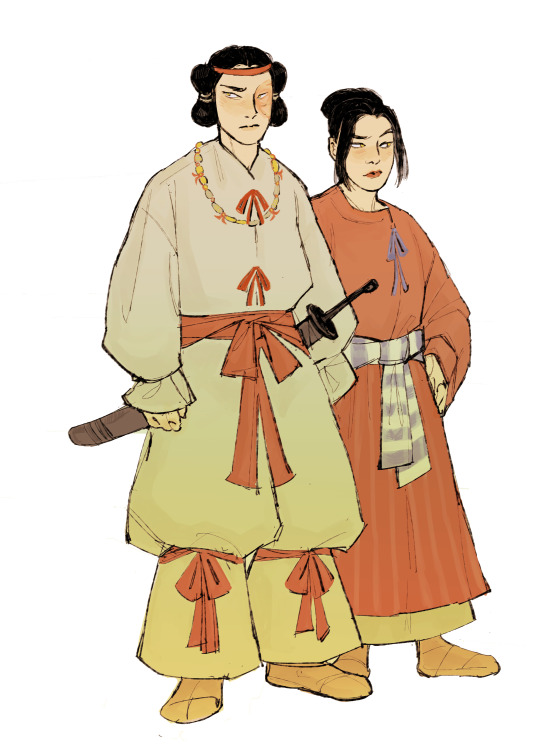
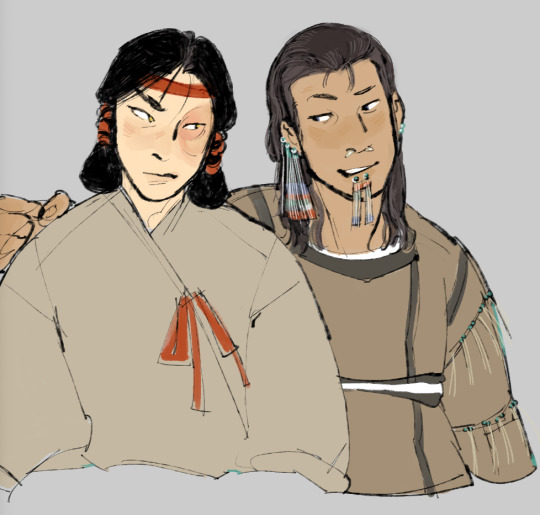
atla isekai but they just get sent back to their pre-unification era ... play with me in this space PLAY WITH ME IN THIS SPAAAACEEE .. if u want .. (scuffs shoes) ..
#no one ever wants to play with me in this space...#zuko#azula#sokka#atla#allgremlinart#of course I have made an issue for myself which is that zuko in kofun period hair is darling but I am the only manufacturer of this content
2K notes
·
View notes
Text
in all seriousness, the fact that uchiha are apparently buried in wooden caskets in a primarily-cremation culture is endlessly fascinating to me
#naruto#like its true that burial was practiced a long time ago#but idk why you would conflate kofun period death rites with a very much sengoku period setting#he probably didnt even think that hard about it. lol
2 notes
·
View notes
Text
Ive been thinking about Xena Warrior Princess and the historical time periods of the show. Xena meets Hercules who is a Greek mythological figure from the bronze age. But she also has dealings with Julius Caesar who lives in the 1st century BC. But then she visits China and they have gunpowder and the ruling dynasty is the Ming Dynasty. But then she goes to Japan but its not bronze age Yayoi era or iron age Kofun period Japan, its like Sengoku period Japan with samurai and such. So like, when did Xena actually live? When did all this take place?
Perhaps I'm overthinking it.
112 notes
·
View notes
Text

A lil concept sketch for Tsukuyomi, the god of the moon. I took lots of inspiration from prehistoric japan for the robes, specifically the tail end of the Kofun period.
157 notes
·
View notes
Text
ngl, i'm a subscriber to the "yong-soo is older than kiku" club too...i know canon says he's 15 or 16 but...eh. i do like some aspects of canon, like its depiction of him being tall and capable of projecting a photogenic image (more so than yao and kiku). but...is there justification for him being that young? old man yong-soo feels like it fits in way better with Korean history imo, and please i cannot resist the whole "the old master and his rival apprentices" dynamic between yao, yong-soo and kiku, with yong-soo being the "older" apprentice—given Korea's tremendously important role as the route through which several Chinese cultural elements were transmitted to Japan in real life (kanji, for one). that is on top of other elements of Korean culture that Japan imported, or Korea being the source of iron weapons and armour during japan's kofun period (300 to 538 AD)—and later, also advanced ship-building techniques.
i feel like it adds further dimension to how we might otherwise have a simplified view of the sinosphere as a universe where yao is the one who turns the wheel of "civilisation": it's also yong-soo taking those influences in. not passively, but actively incorporating his own cultural elements, before they're all passed on by his monks, traders, philosophers, mariners and soldiers to kiku. and in the modern era, Japanese imperial ascendency and ambition isn't just a yao-kiku dynamic of a weary old master and his talented, regicidal protégé, but with yong-soo, about a total inversion and desecration of the confucian hierarchy of seniority too. more than one older nation has had to endure imperial subjugation to a younger one—but in the shadow of meiji japan's naval power, there's the additional sting that it was him once teaching kiku ship-building a long time ago.
160 notes
·
View notes
Text
The Kanji for Sukuna's fire-based technique is 竈 which is used to refer to a traditional Japanese wood or charcoal fueled cooking stove. They are called Kamado (かまど) and were originally invented in China, but spread to Japan through Korea during the Kofun period. Since it was introduced from Korea, the word Kamado itself finds root in the Korean word Gama (가마), which means a Buttumak (부뚜막, Hearth).
#i am still not sure why they wrote furigana as [カミノ]...#it reads as Kamino and can mean Divine's (God's)...#should we be interpreting it as 'Divine's Hearth'?#jjk spoilers#jjk#jujutsu kaisen#sukuna#ryomen sukuna
33 notes
·
View notes
Text
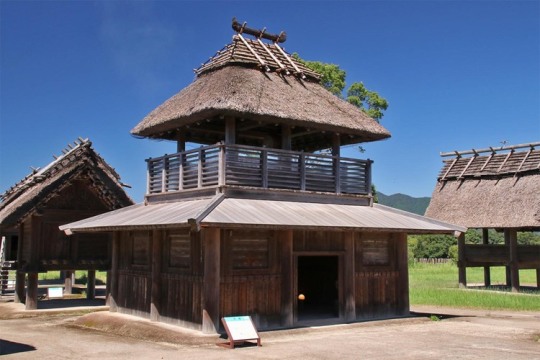



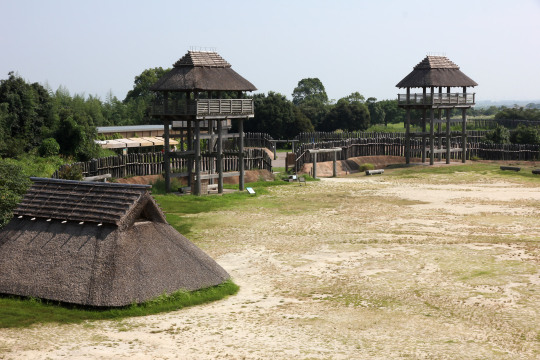
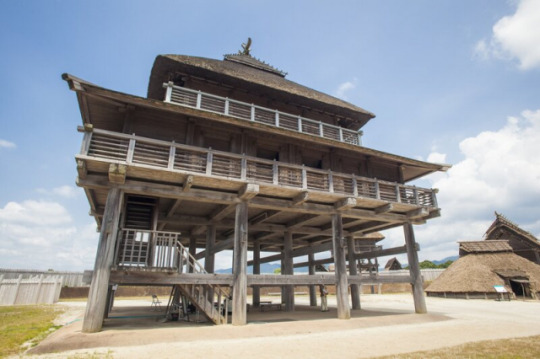
Sean bienvenidos, japonistasarqueológicos, a una nueva entrega de arqueología nipona, una vez dicho esto pónganse cómodos qué empezamos.
-
Nos volvemos a trasladar a la prehistoria japonesa que, cada día, nos sorprende con un nuevo hallazgo arqueológico. Las ruinas de Yoshinogari, datan del periodo Yayoi(III-IV) pero en este caso del Yayoi tardío y se localizan en la prefectura de Saga¿Cuándo llegó el arroz a japón? Y¿por dónde llegó? Hay dos teorías: una que llegó de china y la otra desde Corea hasta la isla de Kyushu a través del mar de Ariake. El enorme asentamiento está rodeado por tres fosos y es la raíz de los castillos en Japón, ha sido seleccionado como uno de los 100 castillos más famosos de Japón.
-
En el periodo Yayoi, se caracteriza porque es cuando aparecen las clases guerras y las clases dirigentes a raíz de la acumulación de poder, esto corresponde a los jefes locales, por ejemplo: La residencia de la clase dominante en el recinto interior sur, no confundir con realeza japonesa, hay que recordar que a los poblados se les instalaba un punto religioso, por aquella época predominaba el Sintoismo como: es el caso del santuario principal construido en el recinto interior norte.
-
El yacimiento cuenta con atalaya del recinto interior sur, de carácter defectivo, al sur se encuentra el pueblo con viviendas tipo foso y almacenes para guardar el arroz rojo que era el que se cultivaba en aquella época y en la ciudad de Karatsu, también en la prefectura de Saga, se encuentran las ruinas de Nabatake, las ruinas de cultivo de arroz más antiguas de Japón.
-
Durante el periodo Yayoi y Kofun tuvieron lugar una serie de migraciones desde la península de corea, esto trajo consigo que las poblaciones coreanas y japonesas de la zona se mezclaran generando mestizos, además de transmitir sus conocimientos de la agricultura.
-
Espero que os haya gustado y nos vemos en próximas publicaciones, que pasen una buena semana.
Welcome, Japanese archaeologists, to a new instalment of Japanese archaeology, so make yourselves comfortable and let's get started.
-
We move back to Japanese prehistory, which surprises us every day with a new archaeological find. The ruins of Yoshinogari, dating from the Yayoi period (III-IV) but in this case from the late Yayoi period, are located in the prefecture of Saga When did rice arrive in Japan? And where did it arrive? There are two theories: one that it came from China and the other from Korea to the island of Kyushu via the Ariake Sea. The huge settlement is surrounded by three moats and is the root of castles in Japan, it has been selected as one of the 100 most famous castles in Japan.
-
The Yayoi period is characterised by the emergence of the warring and ruling classes as a result of the accumulation of power, this corresponds to the local chiefs, for example: The residence of the ruling class in the southern inner precinct, not to be confused with Japanese royalty, it should be remembered that the villages had a religious point installed, at that time Shintoism predominated, such as the main shrine built in the northern inner precinct.
-
The site has a watchtower in the southern inner enclosure, which is defective, to the south is the village with moat-like dwellings and warehouses for storing the red rice that was cultivated at the time, and in the town of Karatsu, also in Saga Prefecture, are the ruins of Nabatake, the oldest rice cultivation ruins in Japan.
-
During the Yayoi and Kofun period a series of migrations from the Korean peninsula took place, which resulted in the mixing of the Korean and Japanese populations in the area and the passing on of their knowledge of agriculture.
-
I hope you liked it and see you in future posts, have a good week.
#日本#韓国#考古学#遺跡#佐賀県#九州#歴史#先史#新石器時代#文化#吉野ヶ里遺跡#地理#弥生時代#有明海#唐津市#鍋岳遺跡#ユネスコ#photo#japan#archaeology#archaeologicalrests#Prefectureofaga#Kyushu#history#prehistory#neolithic#riceculture#Yoshinogariruins#geography#yayoiperiod
28 notes
·
View notes
Text
勾玉
まがたま
magatama; comma-shaped bead from prehistoric Japan, usually made of jade
From Wikipedia: Magatama are curved, comma-shaped beads that appeared in prehistoric Japan from the Final Jōmon period through the Kofun period, approximately 1000 BCE to the 6th century CE. The beads, also described as "jewels", were made of primitive stone and earthen materials in the early period, but by the end of the Kofun period were made almost exclusively of jade. Magatama originally served as decorative jewelry, but by the end of the Kofun period functioned as ceremonial and religious objects. Archaeological evidence suggests that magatama were produced in specific areas of Japan and were widely dispersed throughout the Japanese archipelago to the Southern Koreanic kingdoms via trade routes.

Photo From: User:Pschempderivative Wikipedia
#日本語#japanese#japanese language#japanese langblr#langblr#studyblr#単語#語彙#japanese vocabulary#歴史#japanese history#tokidokitokyo#tdtstudy
80 notes
·
View notes
Text
I just love the idea of Gojo and reader being soulmates who keeps getting reincarnated (in reality my OC but I wrote it with the reader)
ONE LIFE TIME ISN'T ENOUGH
Part 1/Part 2
It was the Yayoi period when they met for the first time.
He was fifteen years old and he was already the capoclan of a sea tribe. All the man were tall, with dark skin, burned by the sun, with dark hairs and eyes. They were strong, they dominated the sea and the near land, destroying and burning down neighboring tribes. He stood like a God in the middle of his men, stronger than all of them, with blue eyes that didn't look like the sky, white hair and skin, as a snow flake in the middle of an ash field.
No man was able to win against him, no curse was able to stop him. They called him God and he acted like one.
He was only fifteen and his name wasn't Gojo Satoru but he was him. He was at the top of the world.
He met her in war.
His clan was attacking a tribe, the clan of his future wife, choosen by his father, was attacked by them and it was his duty to extract revenge even if he didn't care about them.
There was war, blood dripping down men, screams, women and children crying and then somebody started a fire. It was like the gods decided to destroy the whole word by burning down everything, it looked like a divine punishment. And she was standing in the middle of it. He thought she was a god of war, fighting in the middle of the fire, face covered in blood, shooting arrow killing his men and the other clan men one after the other. Who was she?
He walked in the fire circle and fought against her and for the first time he felt alive, while watching her vibrant eyes and the smile on her lips. He never had so much fun before in a fight.
The two fought all night, all day, until the next morning when they stoped, no one else was around, all run away from the fire but them.
And then they start to meet there again and again, to fight, to talk, to run on the woods and swim on the river.
And then on the day of his wedding he run away with her, not caring about anyone else in the world, not his clan nor his responsibility. She was the only thing that had value on his life.
It was the most beautiful time of his life, being free and wild, living only by themselves, going from clan to clan together, and being with her. Nothing else in the world mattered.
They created another clan, with strong people, sorcerer helping them fight curse and they were getting paid by the tribes with food, a sleeping place and whatever they needed. People acted as if they were God and they felt like one.
And then the world crushed into him when he realized how mortal they were, the blood coming from her while crying, the baby growing in her slowly killing her from the inside. She fought with nail and teeth, renouncing to her own powers just to keep the baby alive, for him, because he needed a son.
She slowly died between his arms and he cried day and night, holding her to his heart while she grow weaker and weaker. They promised to each other to meet in the next life and to be happy again.
The second time they met was during the Kofun period. She was the daughter of a blacksmith, he was the best and she was secretly learning from him. A queue of men was always out of the shop, watching her and trying to make her fall for them. And then he, Satoru, arrived. His name was different but it was him. He had eyes like the sky, and plush pink lips. He was a samurai and a sorcerer, while she was a sorcerer and a blacksmith like her father.
He saw her working and he decided that he wanted a sword made by her. He came by every single day, tormenting her and pestering her on how he wanted his sword.
Every single one of her sword didn't work for him, too light, to heavy, too long and too short, and yet he wanted one made by her.
It took her twenty years to do the perfect sword, one he wanted to use.
He accepted it on his death bed, laughing and coughing about how finally she learned how to make a good sword, one he could use. Her last word to him was to tell him how annoying he was and how one say she will get back to him, and he laughed before telling her that he hoped to have this fun again in his next life.
The third time they met was in the Asuka period. He was a warrior in search of fame and fortune, fighting curses and men, to be known as the strongest. People were starting to tell legends about him, a man so beautiful that people had to close their daughter in their house, who looked like the first winter snow and as strong as the storm. He met you when he decided to destroy the terrible band of rogue who was destroying the south of Japan, attacking clans and tribes, fighting the Yamada clan, taking their food and money away, killing their men. People talked about monster and demon, yet not a lot of curses where there.
When he went to destroy all the brigands there he met her, with wild hair and a long scar on her face. She laughed at his face before fighting him, he won but he was unable to kill her. And after that day he always had to put up with her.
Wherever he traveled she followed, taking horror and terror with her. When he slept she tried to assassinate him. When he ate she tried to poison him. When he showered his water was always incredibly cold. When he got undressed his clothes disappeared.
It was the most annoying thing in his life.
They fought, and fought and fought. He would have been lying if he said it wasn't funny to fight against her.
And then she died in the battlefield, nor because the enemy was too strong but to protect his son. He said to her that she would protect her in another life while she answered to him that in another life she hoped they could fight alongside.
The fourth time they met was during the Heian period. A struggle of power was going on between the emperor sons, and yet he didn't have to fight as he was not a soldier but a sorcerer. He was taking car of curses destroying village in his clan territory when he stopped near the soldiers to talk with them, knowing curse were going to rise up there. During the night an attack was carried out, the soldier were killed by arrows so silently that he could have missed them if not for his eyes. Then he searched for the killer, her. She was beautiful and angry, as if her face was a mask.
He decided not to fight but to follow her out only of interest and he learned how she was the leader of a group of farmers, not warriors, and she was putting them in harm way even if she was an hunderd time stronger than them.
It was dishonourable or so he thought until she heard her speech to women and men, until he heard her anger and she undressed in front of everybody to tell them how her body was destroyed by that men, how they needed to kill to save themselves and how even dying in battle was better than that. Everybody listened as if it was the emperor himself talking to them.
And they fought and killed and died. Leaving only her standing to fight again. And he decided to help. Maybe because he was touched or maybe because she looked as if fire was in her vein. They fought, and fought again. And then when they got older, he claimed the land for his clan, letting her live there, asking her to stop fighting but she didn't listen. They ended the fight when he died by the end of a Shikigami, him destroying it to protect her.
They promised each other to be friend in their next life.
#gojo satoru x reader#gojo satoru#gojo x reader#jjk men#gojo x oc#jjk men x reader#gojo#gojo satoru x you#gojo x you
129 notes
·
View notes
Text
Time Travel Question 23: Ancient History XI and Earlier
These Questions are the result of suggestions from the previous iteration.
This category may include suggestions made too late to fall into the correct grouping.
Please add new suggestions below if you have them for future consideration. All cultures and time periods welcome.
Sorry about the extra potato.
#Time Travel#Sumatra#Indonesia#Toba Eruption#Tanzania#Mt. Kilimanjaro#Volcanoes#Metalworking#Delhi#Micronesia#Kofun#Japanese History#Emperor Constantine#Indigenous History#Kelp Highway Migration#Paleolithic#History of Food#Potatoes#The Andes#North America#Central America#South America#Domestication
49 notes
·
View notes
Text
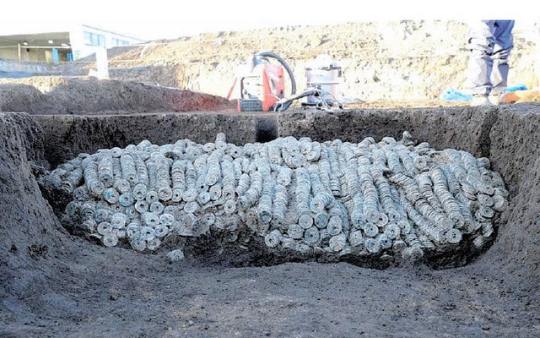
Massive Trove of Ancient Coins Found in Japan
In an excavation at the Sosha Village East 03 archaeological site in Maebashi City, Japan, archaeologists stumbled upon a remarkable discovery – a cache of over 100,000 ancient coins, some of which are of Chinese origin and are more than 2,000 years old.
This excavation was prompted by the construction of a new factory in Sojamachi district here at the area.
These coins include the “Ban Liang,”(coin from 175 B.C.) China’s first unified currency, as well as others dating from the seventh to the thirteenth centuries. What’s more, they were bundled in groups of around 100 coins and secured with straw cords known as “sashi.”
The coins were probably buried quickly because the location was close to opulent homes belonging to influential people in medieval Japan, maybe as a precaution against impending war.
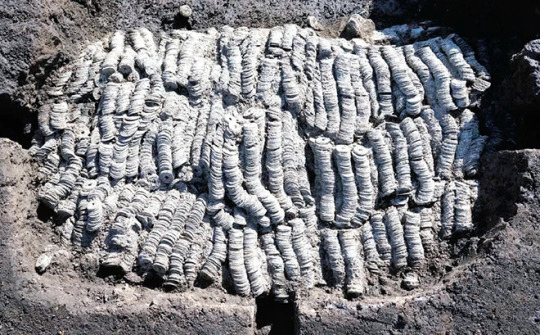
The unearthed coins were found in an area approximately 60 centimeters high and one meter wide, with a staggering 1,060 bundles of these sashi clusters. Some bundles contained evidence of 10 sashi, equivalent to roughly a thousand coins, all arranged with traces of rice straw mats.
A thorough examination of 334 coins from the haul revealed an astounding variety of 44 different currency types. These coins originated from as far back as China’s Western Han Dynasty, extending to the Southern Song Dynasty.
The oldest among them, the “Ban Liang,” dates back to 175 B.C., with distinct characteristics including a 2.3-centimeter diameter, a 7-millimeter square hole in the center, and a thickness of 1 millimeter, featuring the inscriptions “liang” on the left and “ban” on the right.
The most recent coin in this treasure trove was minted in 1265 during the Southern Song Dynasty, leading experts to believe that these coins were hidden during the turbulent Kamakura period (1185-1333). It should be noted that the dating results are preliminary and may be refined through additional research.
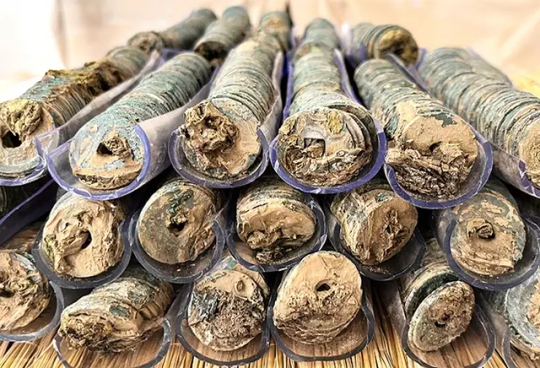

The archaeological site is part of an area encompassing approximately one kilometer, including the Sosha burial mounds, the San’o Temple Ruins, and the Ueno Kokubunji Temple, indicating the region’s prominence as a center of activity from the late Kofun period to the Ritsuryo period.
The extraordinary artifacts from the Sosha Village East 03 site are currently on display at the “Newly Excavated Cultural Artifacts Exhibition 2023” in Maebashi City’s Otemachi district, which is open to the public until the 12th of this month. The event is free to attend.
By Oguz Kayra.
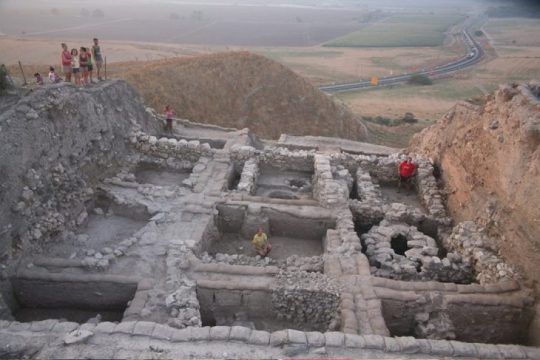
#Massive Trove of Ancient Coins Found in Japan#Maebashi City Japan#treasure#coins#collectable coins#ancient coins#ancient artifacts#archeology#archeolgst#history#history news#ancient history#ancient culture#ancient civilizations#ancient japan#japanese history
43 notes
·
View notes